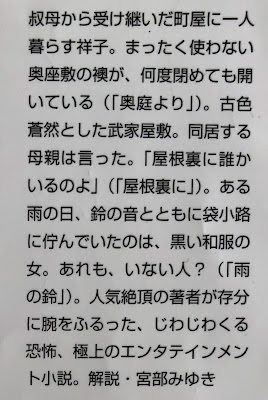目次 / Contents
1) 小野冬美作品 / Fuyumi Ono's Works
2) 営繕かるかや特設サイト/ Eizen Karukaya Special Site
 |
表紙 画 : 漆原 友紀 (ウルシバラ ユキ/ 1974~)
表紙デザイン : 鈴木 久美 (スズキ クミ / ?~)
"Eizen Karukaya Kaiitan : Mysterious Incidents Stories"
(Part 1&2)
Cover Illustration by Yuki Urushibara (1974~)
Cover design by Kumi Suzuki (?~) |
1) 小野冬美作品 / Fuyumi Ono's Works
ホラー小説作家として、小野 不由美 (オノ フユミ / 1960~) さんは 人気があります。
私は、一般のホラー作品は、読む前から、苦手意識がむくむくと起き上がり、読んだことがありません。
ですが、小野 不由美さんの作品は好きです。
ですが、'正しくホラー' を感じさせる彼女の作品は、読んでいません。
『屍鬼』(上下巻 / 1998 /新潮社)は、私にとっては、ホラー作品系の限界です。
小野 不由美さんのある一部のホラーが大丈夫なのは、ただ怖がらせるストーリーではなく、人間の悲しさや寂しさがあり、また、私の好きなファンタジー要素が感じられるからです。
このシリーズは王道のホラーではありませんが、結果的にシリーズの最初の本となった『魔性の子』はホラー小説の中に含まれます
が出ましたが、その後は、作者の体調、その他の事情によって、長らく止まっていました。
今夏、何かの紹介で知った
(2018/ 角川書店) を、おそるおそる読み始めました。
私は、営繕という言葉とその意味:建造物を造ったり修理したりすることを初めて知りました。
確かに最初はこわい...いけるか私?とドキドキしつつ、読み進めました。
う〜ん、やっぱり好き!
6編の短編集でした。
ある城下町でおきる怪奇なできごとを営繕屋の若い男性、
尾端 (オバナ) がほとんどの場合、あっさりと解決します。
尾端は、霊能力のような、なにか特別な力はなく、大工仕事の腕と彼の経験からくるであろう知恵によって解決します。
各物語の主人公は違いますが、尾端が共通の登場人物です。
家を直しつつ、その場の空気や関わる人々の気持ちまでも修復する営繕屋です。
余韻を残しつつ物語は終わります。
怪異現象を完璧にとめず、この世のものではないものを徹底的に消し去るのでなく、共生してゆく方法を尾端はとります。
東洋的な解決策だと感じます。
恐怖も多少その余韻に残すという、その加減が絶妙です。
本格的ホラーが読めない私が、このシリーズは楽しめるとわかりました。
物語の面白さと怖さを楽しみながら、早く営繕屋の尾端が登場して欲しいと願いながら読みました。
こちらもきっと読むと思います。
 |
Eizen means building and repair 2018 / Kadokawa
Contents in Japanese |
 |
奥庭より (表紙の一部) こわいでしょう〜?
'From Inner Garden' (A part of the cover) Scary, right? |
 |
'雨の鈴'
(表紙の一部)
'Ame-no-Suzu : Rain Bell'
(A part of the cover) |
Fuyumi Ono's Works
Fuyumi Ono (1960~) is popular as an author of horror novels.
I've never read a general horror work because I am aware that I am not good at horror novels even before I read it.
However, I do like Fuyumi Ono's works.
However, I haven't read any of her works that feel 'properly horror'.
Therefore I haven't read "Ghost Hunt Series", which is said to be her breakthrough work.
"Shiki" : ["Corpse Demon" or "Death Spirit" / Volumes 1&2 1998 / Shinchosha] is the limit of horror novels for me.
For me, some of Fuyumi Ono's horror stories are okay because they're not just scary stories, they have human sadness and loneliness, and I can feel my favourite fantasy elements.
Although this series is not a classic horror novel, the first book in the series, "The Demonic Child : Mashō-no-Ko", is included in the horror novels (low fantasy horror novels).
The main story of the Twelve Kingdoms series, "Tasogare no Kishi Akatsuki no Ten", was released in 2001, but after that the series was put on hold for a long time due to the author's physical condition and other circumstances.
18 years later in 2019,
"Silver Ruins Gen no Tsuki : Shirogane no Oka Kurotsuki"
(Volumes 1-4) was published.
I read it last year, below.
This summer, I found through some introduction
For the first time, I found about the word Eizen : 営繕 and its meaning : "building and repairing a building".
It's certainly scary at first... can I do it? ...with my heart pounding,
I read on.
Hmm, I really like it!
The book is a collection of 6 short stories.
Obata does not have any special powers, such as psychic powers, but rather a carpenter's skill and wisdom that seems to come from his experience.
The protagonists of each story are different, but Obata is the common character.
He is a repairman who repairs the atmosphere of the place and the feelings of the people involved while repairing the house.
The story ends with a lingering aftertaste.
Rather than completely stopping the supernatural phenomena and completely erasing the things that are not of this world, Obata takes
a method of coexisting with them.
I feel these are oriental solutions.
The balance is exquisite, leaving some fear in the afterglow.
I can't read serious horror, but I found this series to be enjoyable.
While enjoying the fun of the stories, and fears I read it hoping that Obata the repairman would appear soon.
I haven't read "Eizen Karukaya Kaiitan : Mysterious Incidents Stories"- Part 3" (2022), which has already been published.
I'm sure I will read it too.
 |
2019
Contents in Japanese Commentary by Kyoya Origami (1980 ~) |
2) 営繕かるかや特設サイト
Eizen Karukaya Special Site
角川書店のサイトで、営繕かるかや特設サイト : ★ が開設されています。
そこにアクセスしていただければ、各短編のあらすじ: ★が載っています。
サイトには、舞台になっている街の地図やイラストが載っていて、視覚的にも楽しめます。
"この作品の舞台である「河口に位置する小さな城下町」は、小野さんが生まれ育った大分県中津市がモデルと推測される。
そこで中津市をイメージした町の地図に「営繕かるかや怪異譚」1巻&2巻に登場する建物を配置し、「私家版・かるやかマップ」を作成してみた。
~~~
※本企画はフィクションです。実在の地図の地名と小説の舞台の舞台とは関係はございません。"
角川書店が特設サイトを作るほど、小野さんが人気作家であることがわかります。
このシリーズは、日本文化にある怖い話やイメージが基盤にあるので、私は勝手により想像して、より容易く(タヤスク)怖くなります。
ホラーの要素がありながら、小説としての品を保っているところが素敵です。
 |
私家版・かるやかマップ
地図制作:REPLAY(リプレイ)
殺人事件が多発する杯戸町や米花町の名探偵コナンを
思い出してしまいます(笑)。
Karuiyaka Map for the Special Website
Map created by REPLAY
It reminds me of Detective Conan in Haido Town and Beika Town
where murder cases occur frequently, ha, ha.
画像は下記より / This from below
★ |
Eizen Karukaya Special Site
for 'Eizen Karukaya '.
If you can access here → ★, you will find a synopsis of each short story, however, it is only in Japanese, sorry.
The site has a map and illustrations of the city that is the stage, and you can enjoy it visually.
According to the commentary of the map from their website : ★ "The location of this work, 'a small castle town located at the mouth of a river', is presumed to be modeled on Nakatsu City, Oita Prefecture, where Ono was born and raised.
Therefore, we arranged the buildings that appear in the 1st and 2nd volumes of 'Eizen Karukaya Kaiitan' on a town map that imagined Nakatsu City, and created a 'Private version Karuyaka map'
~~~
※This project is fictional. There is no relationship between the place name on the real map and the location of the novel.".
You can see that Ono is a popular author so much that Kadokawa Shoten has made the special website.
This series is based on scary stories and images in Japanese culture, so I think it's easier for us to imagine and get scared.
The story of the book is interesting and draws me in.
It's wonderful that it retains the elegance of a novel while having elements of horror.





















